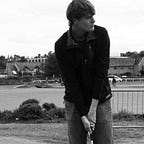Pilot Wave Theory and Time
I’m becoming more and more intrigued by Pilot Wave Theory’s (DeBroglie–Bohm theory) description of the mechanisms underlying quantum dynamics. Specifically, it seems to do a good job of sensibly illustrating quantum phenomena without the need to believe in some of the more exotic aspects of the Copenhagen interpretation or the many-worlds interpretation. Granted the Copenhagen interpretation is still more accepted by the mainstream, and is mathematically more efficient. In its current form, pilot wave theory may be inconsistent with special relativity, but it’s fun to think about.
Taking a step back from the math and thinking about pilot wave theory more broadly (which could get me into trouble, but here goes), I’ll jot down intuited explanations for two of the more problematic aspects of pilot wave theory. Let’s start with the one that I resonate with most:
- For pilot wave theory to make sense, there must be a sort of dynamic universal underlying medium (many conceptualize as vibrating or wave-like substrate). In the typical pilot wave conceptualization, that substrate is behaving like a wave and is oscillating. These wave-like oscillations in the substrate explain quantum dynamics like dual slit probabilistic vs definite location / momentum dualities in particle behavior. But, the need to believe in some unseen vibrating universal substrate is a big hurdle to overcome. Here’s my suggestion for that substrate: time. Or, more relativistically speaking, the progression of spacetime.
- Many will argue that pilot wave theory necessitates a deterministic view of the universe. That’s true only if the substrate is fundamental and immutable or, at the very least, stable and uninfluenced. But, if time (spacetime) can be warped, punctured, dilated or otherwise bent (which we know it can), the medium underlying pilot wave theory is not immutable and therefore the trajectory of the universe isn’t necessarily deterministic.
Pilot wave theory is only fully deterministic if you know the initial state of a system and the wave function of the pilot/guiding wave. But, if the wave function is dynamic or mutable, the system is not deterministic — you can’t always calculate where each particle will end up.
Steinberg et. al.’s experiment might give credence to the thought that the pilot wave is time (the progression of spacetime). In their entangled photon & beam splitter experiment, Steinberg and his colleagues found that the answer to the question “Which path did the first photon take?” depended on when it was asked. In the moments immediately after the first photon passes through the beam splitter, the second photon is very strongly correlated with the first photon’s path. “As one particle goes through the slit, the probe [the second photon] has a perfectly accurate memory of which slit it went through,” Steinberg explains. But as time passes and the first photon travels further, the detector photon’s report becomes less reliable. So, if you conduct your measurement of the observation photon’s orientation shortly after the original photon passes through the beam splitter, the pilot waves haven’t yet interacted. If you wait until later, after time-based pilot wave interference has taken place, you will observe surrealistic path data. Basically:
Potential Experiment:
Intuition is that we’d want to test whether time is the pilot wave / universal substrate. Perhaps you could do this by conducting Steinberg-style pilot wave theory experiments in an environment with unstable time and measure how those perturbations in spacetime impact the results. This is easier said than done, but maybe there are methods — e.g., conduct the experiment continuously while monitoring gravitational waves, and analyze the correlation of results. If tachyon neutrinos are found to be a thing, see how their presence might impact the results.
2020 Update: Gravitational waves, even more interestingly specific resonances of gravitational waves, affect entanglement in vacuum (https://arxiv.org/abs/2006.11301). This could support deBroglie-Bohm theory with the progression of time (relativistically speaking, spacetime) serving as the underlying pilot wave. The resonances are particularly interesting in that they may reveal harmonics with perhaps a frequency or dimension of spacetime wave that is beyond the scope of direct measurement.
